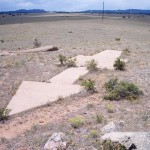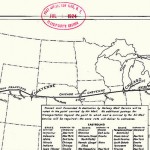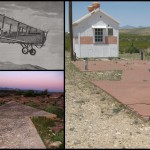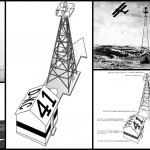What are these giant concrete arrows across the American Landscape?
![]() Posted by hipstomp / Rain Noe/from Core77
Posted by hipstomp / Rain Noe/from Core77
Backpacking through Europe in my 20s, my sense of direction served me well—until I hit the cities with the truly medieval street plans. So in Florence, after renting a motorcycle, I devised a clever way to find the garage again: Next to the garage was an impressive, obviously important brick building, with a large arrow and some Italian words pointing to it. I observed these same signs along the street pointing back towards this building, so I knew that if I got close enough, the signs would lead me back to the building and the garage.
Attempting to return at the end of the day, I located the signs, began following them—and was soon hopelessly lost. It was only after going in a complete circle that I realized what was written on the sign—Senso Unico—was Italian for “One Way.”
To follow arrows is human-behavior-meets-graphic-design 101. So it may not surprise you to learn that these gigantic concrete arrows dotting America, from east to west, are for wayfinding.
In the 1920s, America began coast-to-coast Airmail service, but the pioneer pilots had trouble navigating the route, since navigation charts of the day were fugazi and you couldn’t exactly pull over to ask a farmer for directions. And traveling at night, when it would have been most efficient, or in bad weather was impossible. To solve this Congress then funded these gi-normous arrow-shaped Airmail Beacons, some up to 70 feet long, to trace a route across the country.
The arrows were painted bright yellow and each was accompanied by a tower up to 50 feet in height. At the top of each tower was a powerful gas-powered light, and at the bottom of the tower, a shed to hold the gas.
The easily-discernible design made the arrows visible from a distance of ten miles, and each arrow pointed the way towards the next, some three miles distant. That’s according to the Postal Museum; however, this blog claims the towers were 10 miles apart with a 40-mile visibility. It’s possible the former is describing the earlier towers and the latter is describing updated versions.
What’s not in dispute is that the beacon towers are all gone, the steel having been broken up and recycled for America’s World War II effort. But the no-longer-used arrows remain, their paint long since worn off by the elements, the arrows themselves too difficult to make breaking them up worthwhile. And unless Omer Haciomeroglu sends his Concrete Recycling Robots into the American hinterlands, they’ll likely be there forever.
For more on this story go to:









